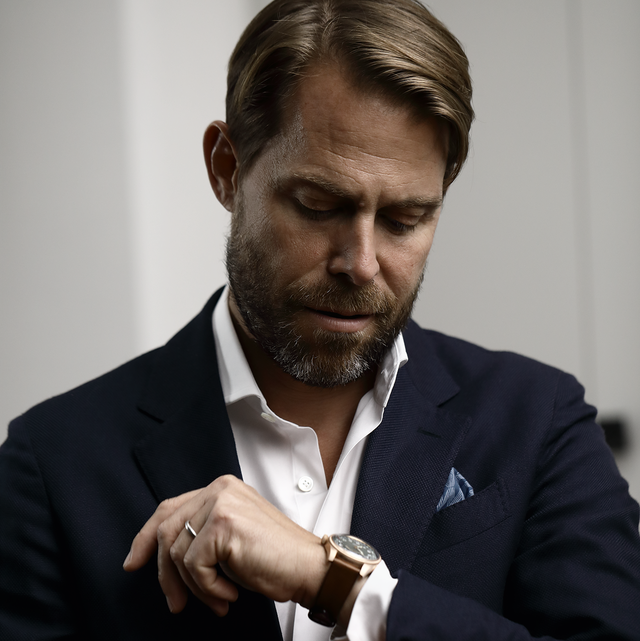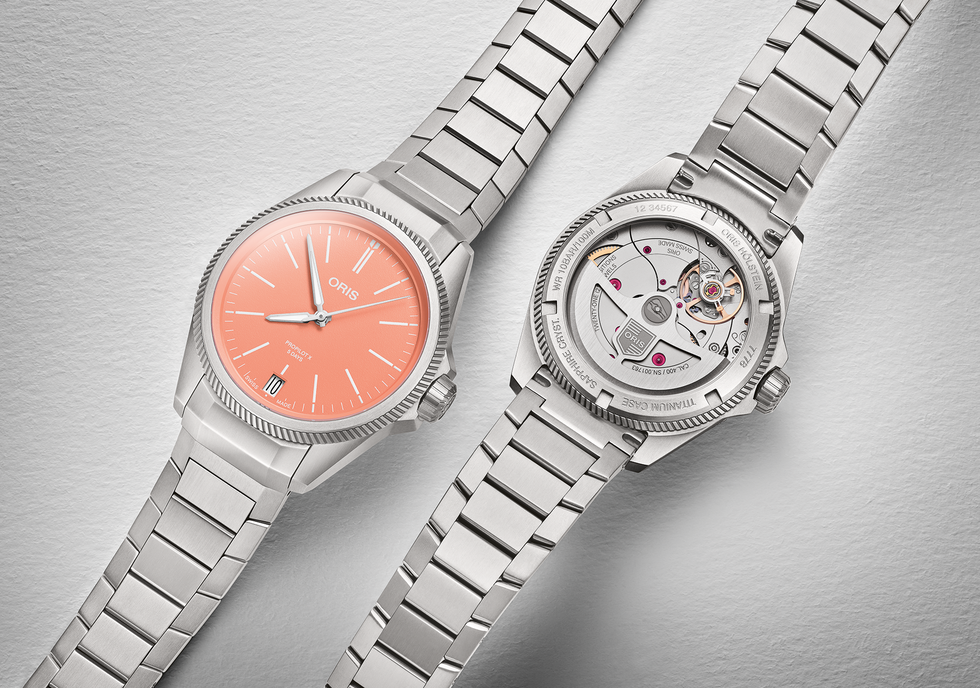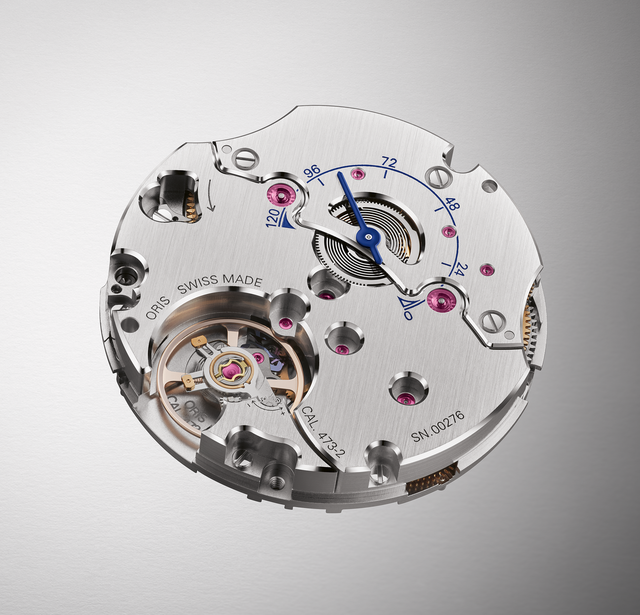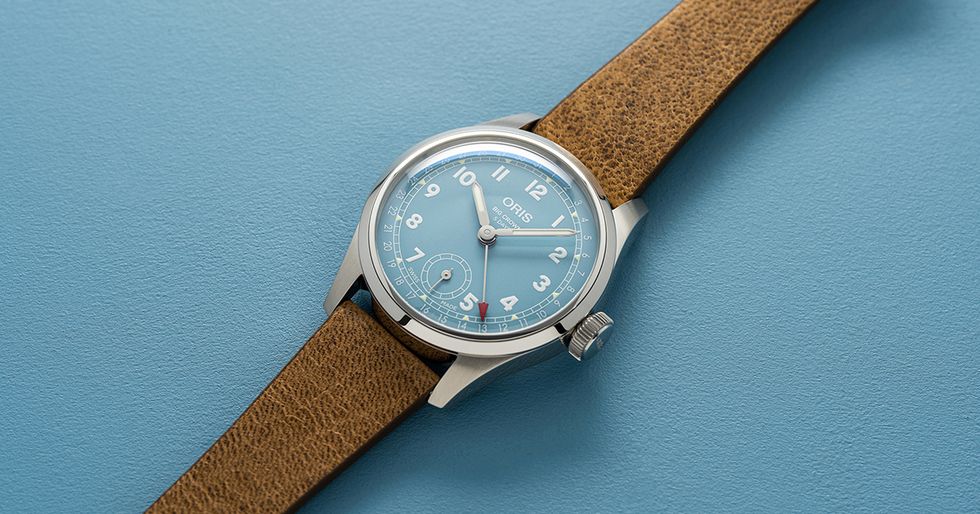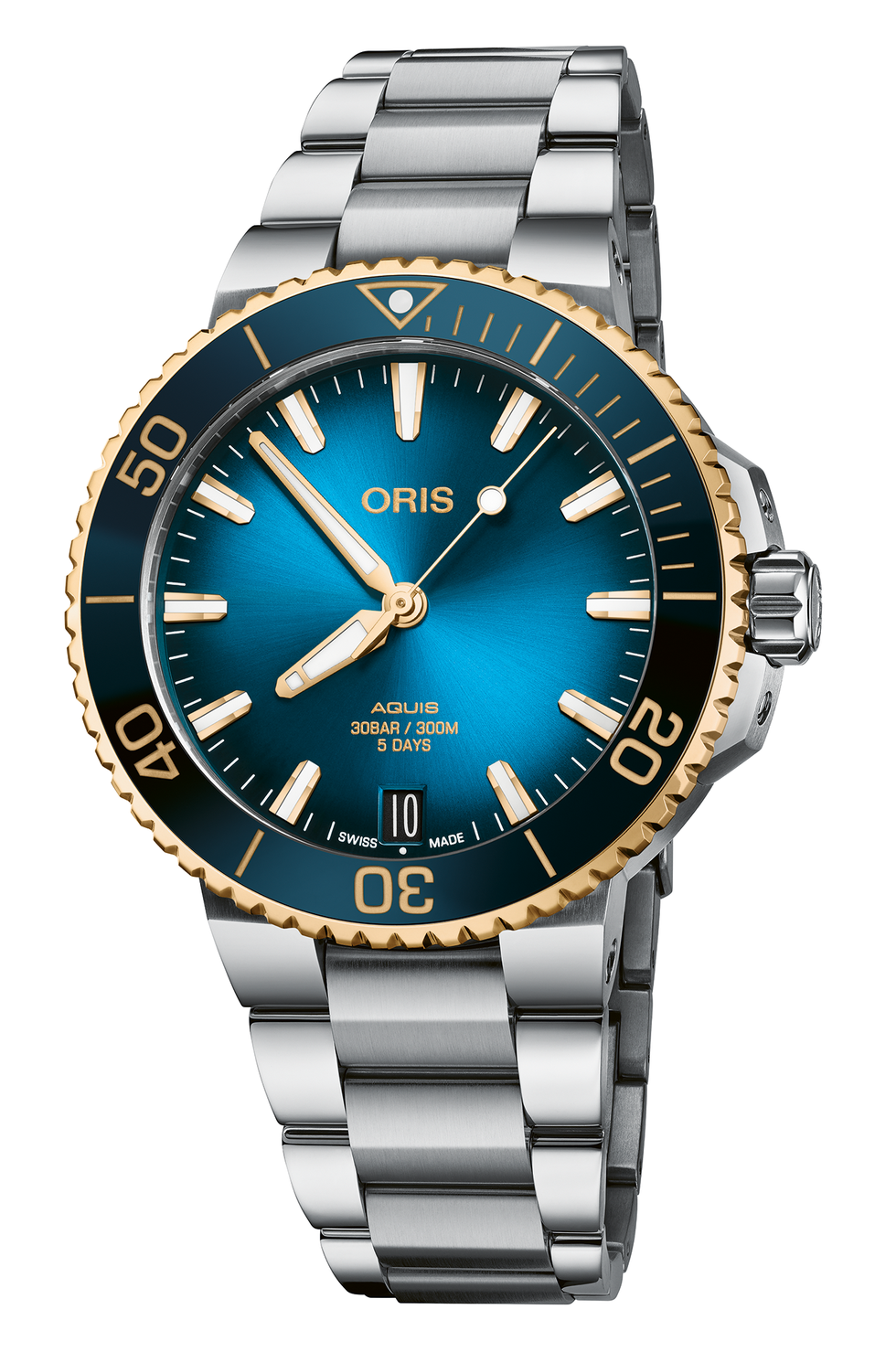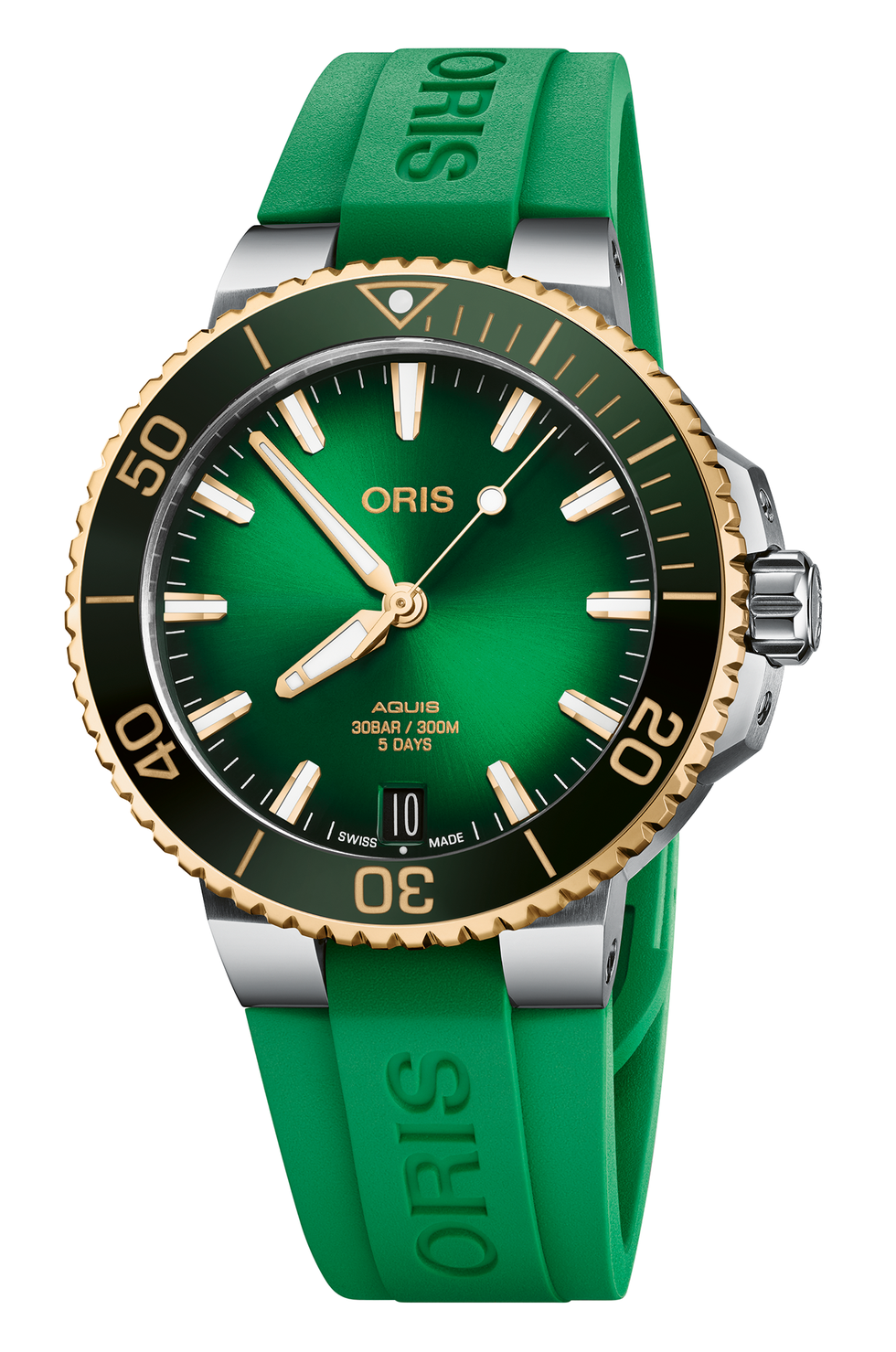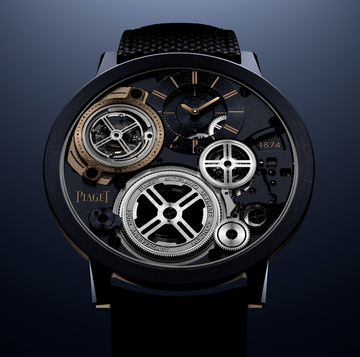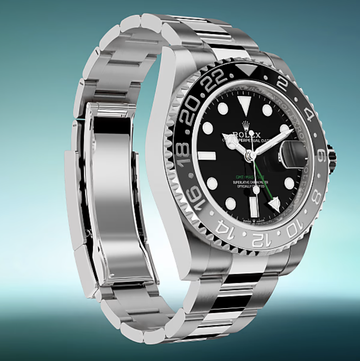More than anything else, Rolf Studer wants his watches to make you happy.
His company Oris stands apart from its more famous Swiss rivals, though it has been holding its own against them for years. You can pick up an Oris watch for the third of the price of an Omega, for example, but not a third of the quality. Oris watches are extremely well-made, good-looking and have features and functions you’ll struggle to find anywhere else in the £2,000-£4,000 category (it also makes watches that cost much more). Oris has been described as ‘possibly the best value in the Swiss-made watch industry’.
The brand has always got plenty of love from the watch community – that’s to say collectors, bloggers and people who know their Patek Philippe reference numbers. Recently it’s become much better-known outside that world, too.
It’s no secret that men’s watch sales have accelerated like never before. More people know more about what makes a good watch than at any other time in history. The big brands will always be the big brands, and with good reason. But there’s room for more of the others now, too.
Another factor is that kind of status a watch can give you has changed. As Studer says, status used to mean ‘heavy and serious’. Now it can mean the opposite. Which is where Oris’s confidence in, for example, colourful dials has really paid off. Why wear a pilot watch with a traditional white dial, like your dad, when you can wear a Propilot X in a pleasing salmon or pewter blue?
Oris has also been pushing its ‘in house’ movements – building the inner workings of its watches itself. Movements are by far the most expensive part of a watch to develop, and for a company to tool-up and make. At the entry-level luxury market, they’re usually bought in.
This is particularly pertinent to the Oris story. The watchmaker has been around since 1904. By the 1960s it was one of the ten largest watch manufacturers in Switzerland. The influx of cheap digital watches from Japan in the 1970s, ‘the quartz crisis’ – almost shut it down.
As people began to get over the novelty of pocket-money priced Casios, Oris was one of the first brands to really emphasise traditional mechanics. Even high-end luxury watchmakers were still using quartz, but Oris rejected it entirely. Its slogan became ‘High Mech’ – as in, high-quality mechanics.
Last month, not long after Oris announced its latest manual-wound movement, the Calibre 473, Esquire Zoomed in with the company’s co-CEO. Studer discussed the brand’s current success, why watches should always make you smile and how staying independent is key to its success.
Why go to the bother of making your own movements?
It gives you credibility, to show what you can do as a brand – that’s one thing. The other thing is that you can build them to your specifications. So when we did our Calibre 400 [launched in 2020], we didn’t want to do just ‘another’ in-house movement. We really wanted to do a movement that we wanted, as watch enthusiasts ourselves, something that had all the aspects that we looked for in a mechanical movement. We gave it a five-day power reserve, so it would last all week. We gave it 10 years of warranty, because no one wants to be bothered with services. And we made it antimagnetic. There are the things that we think make a good movement. So we built it that way.
You probably wouldn’t buy a fancy car with someone else’s engine in it. But it’s different with a watch. So long as it keeps decent time, do most people really care who makes the bit you can’t see?
It’s a very good question. And also: is the [extra] price justified, right? Why do I pay that amount of money for that Patek [Philippe] movement? Why do I pay for that Frederique Constant movement? Every customer should ask himself what’s important to them. For a long time I was of the opinion that, to be completely honest to the customer, it makes more sense to use sourced movements, at our price point. But after Calibre 110 [in celebration of the brand’s 110th year] that we did in 2015 I learned that there is so much value in having your own movement, for the consumer. Especially if this movement does something that’s different from what standard movements do. But you still have to keep your prices within reason.
Still, is it a hard thing to explain to customers?
Well, if [a watch with an outsourced movement] is good enough for you, then don’t [get a more expensive one]! So often we do events and people [new to watches] come up to us and say ‘Hmm… Oris’ and I’m supposed to talk to them about our products. And I have absolutely no interest in doing that! Either you understand, or you don’t. If you have an interest in the topic then I’m very happy to ‘romance’ the brand. But if you prefer cars or your thing is, I don’t know… darts, then spend your money on that. Be happy! And if you like watches, welcome to our world. Because, if you do like watches, there will be the moment when you consider buying an Oris. Because we make a pretty good mechanical watch.
Watches are much more democratic now. The Top 10 ‘must-have models’ lists have gone. There aren’t really any ‘wrong’ choices…
Exactly. And also a watch only comes to life with the emotions you have towards it, you know? That’s why our company purpose really is – top line – to make people smile. This watch must make you smile. And if it doesn’t, please do not get it! And there are always different reasons that we can make you smile. Maybe the dial colour. Maybe the movement. Maybe the size. It doesn’t matter, right? There are different reasons to like a watch, to get engaged with a watch. Whatever works for you is good.
Would you talk us through how Oris navigated the quartz crisis, for people who aren’t familiar with the story?
Yeah, so the quartz crisis basically eliminated our business model. Which was ‘make a good watch for a price point that makes sense’. That was gone. So the people at the company before me really had to reinvent the brand. And they found that, in Japan, in the late Eighties, people came back to mechanical watches because they were tired of those super-precise technological things. They wanted to have something emotional. So we came back and said ‘We will only make mechanical watches’. And that’s how it remained today.
And today sales of mechanical watches are flying
Absolutely. These things are cyclical. When the economy isn’t so good then we [as a business] do badly – and that’s what was happening [in the most recent recession]. And then the pandemic hit. So we storm-proofed the ship… and then [during covid] it was just incredible how demand surged. There was a real shift in our industry. People now know so much more about watches. They had the time [during lockdown] to read up on all these watch magazines, watch blogs, watch supplements and I don’t know what. And they understood much better. It’s similar with [what happened with] wine, right? People are willing to spend more on their watch. Watch collecting used to be a nerdy hobby. Like collecting stamps. And now it’s a cool lifestyle.
It’s a generational shift. Our fathers would have ‘a watch’. Now there’s this idea of having a collection. Or, at least, more than one to swap around with different outfits
Yes, definitely. And that has really helped our industry. It helped Oris in particular because we are a brand that was always appreciated by the watch community. And that community has become a spearhead of the whole industry. After the pandemic nobody questions if the mechanical watch is here to stay, or if it’s a thing from the past. Before, we had all these discussions about smartwatches. And now it’s clear. It’s like good shoes, or a good car. There’s a reason to have them. No one thinks mechanical watches will be obsolete in a few years. So, for me, it’s bringing a circle to an end that started with the quartz crisis.
One Oris trademark is the red rotor, which you can see through the case back of your watches. What’s the story with that?
That came from us being one of the first companies after the quartz crisis to really focus on mechanical watches. It was to signal ‘Hey, you have [a mechanical watch] in front of you’. It has life, it has blood. Hence the red colour.
You’re big on emotional connection
That’s another thing the pandemic accelerated. It accelerated a development in the luxury industry, going from exclusive luxury to inclusive luxury. Exclusive luxury, excluding people, with different levels of what you can afford… it should never be about what you can afford. It should always be about the emotion and the story. And that’s what we are. We still want to make mechanical watches for people who get into the hobby. We don’t want to lose that person who made us who we are today. But we also ‘go up’ [in materials/ price] and make finer things for people who appreciate that. People who own an Oris, they often own [other] very expensive watches, also. That wasn’t the same 10 years ago. So this transparency has really injected a lot of joy and positivity into the business. It wasn’t always easy to get that [message] through [to some of my co-workers]. Because people are proud to make a good, mechanical watch. And they think that is all. But that’s not enough! That is the base! You need to give people joy because that is the only reason why they would spend money on something they don’t really need.
Are there pros and cons to Oris becoming better known?
What’s important to us is our independence. That’s what makes us thrive and makes us push to the next level. Obviously we want to grow. At the end of the day, we are a business. We have grown double digits in the last year, as many brands have also. But it’s also really nice to have a brand where I can tell my own philosophy. And not ‘bow to the king’ [ie: be part of some profit-mad conglomerate].
Your colourful dials have been particularly well-received
That comes from taking watchmaking seriously but not taking ourselves too seriously. And understanding that a watch should cheer you up. These are the three watches I keep on my desk [holds them up to the Zoom camera]… the Divers Sixty-Five with the powder blue dial. The bicolour Aquis Date. And now the 473 with the blue dial. I look at them and they make me happy.
The style media, including Esquire, is always keen to point out ‘trends’ in watchmaking. Do such things really exist? It’s not like the brands secretly get together years in advance and decide ‘2023 will be all about blue dials…’
Three things. First of all you plan [releases] well ahead. So you can’t really go and say ‘I see this other brand has done this, so let’s go and do that, too’. Because [development] takes a long time. But it is also true that you’re sensitive to what’s going on. You see what’s happening in fashion, and in art. When we came up with the cotton candy dials in those three colours [the Divers Sixty-Five in pastel blue, green and pink, first released in 2021] it was really during the pandemic where we said ‘Let’s just have some fun’. And it was so well-received that it gave us confidence to just do the colours we like. And just look – when you look at that dial [holds up the new 473]. Wouldn’t you spend your money on that dial instead of dark blue? Yes! Because it is the happier colour. So: we do sit around the table and say ‘Okay, so this [new watch] is going to be out next summer at some point. What’s happening in the world? Okay, maybe… purple! Why not?’
The choice used to be black or white
Or blue, for casual! And now it can be anything. And it should be, because it needs to be a joyful object. Otherwise you have no reason to spend your money on it. Especially if you take the status away from it. The old-fashioned way of thinking about status. It was ‘elegance’. And it was heavy and serious. And now these things have changed.
Oris has been described as ‘affordable luxury’, ‘accessible luxury’ and ‘value-added luxury’. Are those tags helpful, or annoying?
I really don’t like to position myself. I don’t want to do that. We do our thing and the success that we’ve had over the last few years has very much come from that, from not looking left or right. From just doing our thing. Obviously we are in a price range that to some extent is entry-level for upscale watches. But, as we discussed before, I don’t think it matters. Because the person who appreciates a Parmigiani for what it is or a Chopard for what it is, will also appreciate an Oris or a Nomos for what it is. One is not better than the other. It’s the object that moves you and talks to you that makes it what it is.
The big watch fair, Watches and Wonders, is around the corner. Has Oris got exciting stuff to launch there?
Absolutely. [Leaves enigmatic silence…]
We’ll wait and see, then
It will be a little bit unexpected. And a lot of fun. There’s a few interesting things planned this year.
